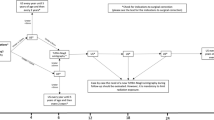Abstract
The authors propose a new explanation for the male preponderance in cases with prenatally diagnosed vesico-ureteral reflux and primary megaureters. The theory is based on conclusions drawn from the characteristics of 4 patients (3 perinatal cases and 1 occurring in a 14-year-old boy) presenting with unusual anomalies of the lower urinary tract. In this hypothesis, the male preponderance could be related to an abnormal dilatation of the posterior urethra occurring during the embryological development of the male urethra. The dilatation leads to a flap valve mechanism and to a functional obstruction of the bladder outlet and finally to secondary dilatation of the upper urinary tract. This obstruction may be transitory; reflux and megaureters found in utero or after birth could be considered as sequellae of this phenomenon.
Similar content being viewed by others
References
Schulman CC, Hall M, Collier F, Avni EF (1991) Fetal vesicoureteral reflux: diagnosis and management. Abstract 354, 86th Congress of the American Urological Association, Toronto, Canada
Steele BT, Robitaille P, DeMaria J, Grignon A (1989) Follow-up evaluation of prenatally recognized vesico-ureteral reflux. J Pediatr 115: 95–96
Scott JE (1987) Fetal ureteric reflux. Br J Urol 59: 291–296
Paltiel HJ, Lebowitz RL (1989) Neonatal hydronephrosis due to primary vesico-ureteral reflux: trends in diagnosis and treatment. Radiology 170: 787–789
Willi UV, Lebowitz RL (1979) The so-called megaureter-megacystic syndrome. AJR 133: 409–416
Gordon AC, Thomas DFM, Arthur RJ, Irving HC, Smith SEW (1990) Prenatally diagnosed reflux a follow-up study. Br J Urol 65: 407–412
Anderson PAM, Rickwood AMK (1991) Features of primary vesico-ureteral reflux detected by prenatal sonography. Br J Urol 67: 267–271
Livera LN, Brookfield DSK, Egginton JA, Hawnaur JM (1989) Antenatal US to detect fetal renal abnormalities: a prospective screening programme. Br Med J 298: 1421–1423
Marshall FF (1978) Embryology of the lower urinary tract. Urol Clin North Am 5: 3–15
Stephens FD (1983) The male urethra. In: Congenital malformation of the urinary tract. Praeger, NY, pp 79–94
Moerman Ph, Fryns JP, Goddeens P, Lauwerijns JM (1984) Pathogenesis of the Prune belly syndrome: a functional urethral obstruction caused by prostatic hypoplasia. Pediatrics 73: 470–475
L'Hermitte J, Six A, Schmitt M, Hubert J, Bretagne MC (1990) Syndrome jonctionnel responsable d'ectasie de l'urètre prostatique: nouvelle entité pathologique? Acta Urol Belg 58: 1: 123–131
Willem C, Doupagne M, Deleval J (1990) Ectasie urétrale chez l'enfant. Syndrome jonctionnel de l'urètre? Acta Urol Belg 58: 58–64
Author information
Authors and Affiliations
Rights and permissions
About this article
Cite this article
Avni, E.F., Gallety, E., Rypens, F. et al. A hypothesis for the higher incidence of vesico-ureteral reflux and primary megaureters in male babies. Pediatr Radiol 22, 1–4 (1992). https://doi.org/10.1007/BF02011598
Received:
Accepted:
Issue Date:
DOI: https://doi.org/10.1007/BF02011598



